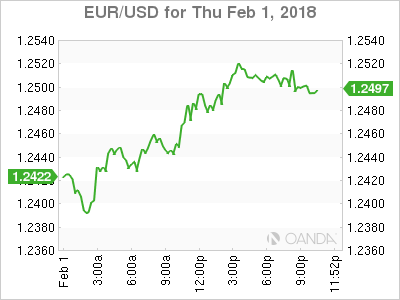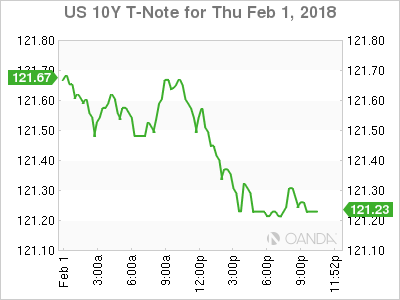US expected to add 184,000 jobs in January
The US dollar fell against a basket of currencies on Thursday. The greenback has failed to gain traction in 2018 and is awaiting the first US jobs report of the year looking for a shot in the arm. The U.S. non farm payrolls (NFP) will be published on Friday, February 2 at 8:30 am EST. Economists are expecting the US to add 184,000 positions and keep the unemployment rate at 4.1 percent. Last month’s report came in lower than expected but the saving grace for the USD was that hourly wages grew 0.3 percent as expected. There are similar gains forecasted for January wages with a special emphasis on inflationary data as the Fed ponders what to do with stagnant wages despite a strong job component.
- European manufacturing gathered steam in January
- Unemployment claims fell last week in evidence of strong US labour market
- Higher growth expectations outside of US putting pressure on dollar
Dollar Lower Despite Support from Central Bank

The EUR/USD gained 0.82 percent on Thursday. The single currency is trading at 1.2515 a day after the U.S. Federal Reserve kept rates unchanged and ahead of the release of the January’s U.S. non farm payrolls (NFP) report. Strong manufacturing data out of Europe continued to make the case for accelerated growth. The European Central Bank (ECB) did not make any changes to its QE program or interest rate in January, but with higher growth and inflation expectations are rising that its bond buying program could end this year with a possible rate hike.
US economic growth continues to soldier on, with the U.S. Federal Reserve forecasted to lift interest rates 3 to 4 times in 2018. Strong fundamentals and a supportive central bank should have the USD higher versus the euro, but political uncertainty going into the midterms has impaired the dollar. Employment has been the pillar of the economic recovery, but at near full employment there is little that even a monster jobs report can do to boost the dollar. The ADP private payrolls report released on Wednesday saw 234,000 jobs added in January, and while there is no perfect correlation between the ADP and the NFP, after the disappointing jobs report in December an improvement is anticipated which could help the USD finish the week higher versus other currencies.
The USD has fallen 3.25 despite so far this year and comments from the Fed that inflation is expected to rise helped only a little. The FedWatch tool by the CME is showing a 83.1 percent probability of a rate hike in March after the release of the FOMC January statement. Growth and interest rate rises have all been priced in, but for some investors the threat of higher political uncertainty during the midterms is a cause for concern.
Next week will offer the USD less opportunities to shine as the main indicator release will be the non manufacturing PMI related by the ISM. Services have slowed down since reaching a reading of 60.1 in October with the forecast for the January figures to be around 55.9.

US bond prices have fallen as a result of higher growth and inflation expectations this year and yields are higher seeking to attract investors that have been tempted by fixed income alternatives overseas.
The USD has been on the back foot against major currencies for most of 2018. The rally that followed the victory of Donald Trump in the November 2016 elections was driven by tax reform and infrastructure promises. The 12 month period before the promise and the reality proved to be too much for a market that was expecting a quicker turn around and the greenback depreciated in 2017. This year follows a similar trend with the euro hitting three year highs and even the pound recovering to pre-Brexit levels thanks to a softer dollar.
Market events to watch this week:
Friday, February 2
4:30am GBP Construction PMI











